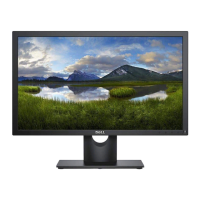How to correct geometric distortion on a Dell Monitor?
- Cchristina48Sep 6, 2025
To correct geometric distortion on your Dell monitor: * Reset the monitor to Factory Settings. * Auto Adjust via OSD. * Adjust brightness & contrast controls via OSD.

How to correct geometric distortion on a Dell Monitor?
To correct geometric distortion on your Dell monitor: * Reset the monitor to Factory Settings. * Auto Adjust via OSD. * Adjust brightness & contrast controls via OSD.
What to do if my Dell E2219HN Monitor shows 'No Input Signal' when pressing controls?
If your Dell monitor displays 'No Input Signal' when you press the user controls, try these steps: * Check the signal source. * Ensure the computer is not in power saving mode by moving the mouse or pressing any key on the keyboard. * Check whether the signal cable is plugged in properly. Re-plug the signal cable if necessary. * Reset the computer or video player.
How can I resolve distorted sound on my Dell E2219HN Monitor?
If you're experiencing distorted sound on your Dell monitor, here are some steps to try: * Clear any obstructions between the Soundbar and the user. * Confirm that the audio line-in plug is completely inserted into the jack of the audio source. * Decrease the volume of the audio source. * Turn the Power/Volume knob on the Soundbar counter-clockwise to a lower volume setting. * Clean and reseat the audio line-in plug. * Test the Soundbar using another audio source (For example: portable CD player, MP3 player).
| Screen Size | 21.5 inches |
|---|---|
| Resolution | 1920 x 1080 (Full HD) |
| Panel Type | IPS |
| Refresh Rate | 60 Hz |
| Brightness | 250 cd/m² |
| Contrast Ratio | 1000:1 (typical) |
| Aspect Ratio | 16:9 |
| Color Support | 16.7 million colors |
| VESA Mount | 100 x 100 mm |
| Connectivity | HDMI, VGA |
| Response Time | 5 ms (gray to gray) |
| Ports | 1 x VGA, 1 x HDMI |
| Viewing Angle | 178° / 178° |
Lists the components included with the monitor.
Details the capabilities and specifications of the Dell E2219HN monitor.
Identifies buttons and indicators on the front of the monitor.
Identifies ports and slots on the back of the monitor.
Provides technical details like model number, screen type, and panel technology.
Details monitor dimensions, pixel pitch, viewing angles, and brightness.
Lists available input ports like HDMI and VGA.
Describes tilt, swivel, and pivot capabilities of the monitor.
Lists video capabilities for VGA and HDMI playback.
Details resolutions, frequencies, and pixel clocks for various display modes.
Specifies analog RGB and HDMI input signal characteristics.
Details power requirements including voltage, frequency, and current.
Provides the physical dimensions of the monitor with the stand.
Lists the weight of the monitor with and without packaging and stand.
Lists certifications like RoHS and TCO.
Specifies operating and non-operating temperature ranges.
Describes the monitor's state during normal use and power consumption.
Explains the low-power state and its indicators.
Details 'On Mode' power consumption and total energy consumption.
Shows pin layout and function for the VGA connector.
Details pin assignments for the HDMI connector.
Provides instructions for cleaning and handling the monitor safely.
Step-by-step guide to assemble and attach the monitor stand.
Simple instruction to turn the monitor on using the power button.
Identifies and explains the function of front-panel buttons.
How to open and navigate the monitor's OSD menu.
Explains the functions of various OSD menu options like Energy Use and Brightness/Contrast.
Details the automatic screen adjustment feature for VGA input.
Describes how to select between VGA and HDMI input signals.
Explains how to adjust color settings within the OSD menu.
Lists and describes preset color modes like Standard, ComfortView, and Multimedia.
How to set the input color format and reset color settings.
Accesses display settings like Aspect Ratio, Position, and Sharpness.
Adjusts the image position horizontally and vertically (VGA input only).
Adjusts image sharpness and pixel clock for optimal quality (VGA input only).
Fine-tunes image quality and sets monitor response time.
Resets display settings and manages energy-related options.
Adjusts OSD language, transparency, and timer settings.
Controls OSD access and resets OSD menu settings to defaults.
Sets shortcut keys for frequently used functions like Preset Modes.
Accesses OSD settings like DDC/CI and LCD Conditioning.
Enables/disables PC control and reduces image retention.
Resets all OSD settings to their factory preset values.
Displays messages for unsupported resolutions or disabled DDC/CI.
Messages for no signal detected or cable connection issues.
Guide for updating drivers for Dell computers to set resolution.
Steps for setting resolution via display settings in various Windows versions.
Instructions on how to tilt the monitor for comfortable viewing angles.
Procedure to test monitor functionality when the screen is dark.
Solutions for monitor having no picture or power.
Solutions for fuzzy, blurry, ghosting, or shaky images.
Solutions for pixel defects and issues with picture dimness or brightness.
Solutions for off-center images or screen displaying lines.
Solutions for scrambled screens, missing, or wrong colors.
Actions for safety hazards and intermittent monitor malfunctions.
Solutions for faint shadows from static images on screen.
Solutions for images not filling screen or unresponsive controls.
Solutions for 'No Input Signal' and aspect ratio problems.
Solutions for soundbar power issues and lack of sound output.
Solutions for distorted audio output from the soundbar.
Solutions for unbalanced or low volume soundbar output.
General safety warnings regarding control use and potential hazards.
Information on FCC compliance and other regulatory matters.
Information on how to contact Dell for technical support and assistance.